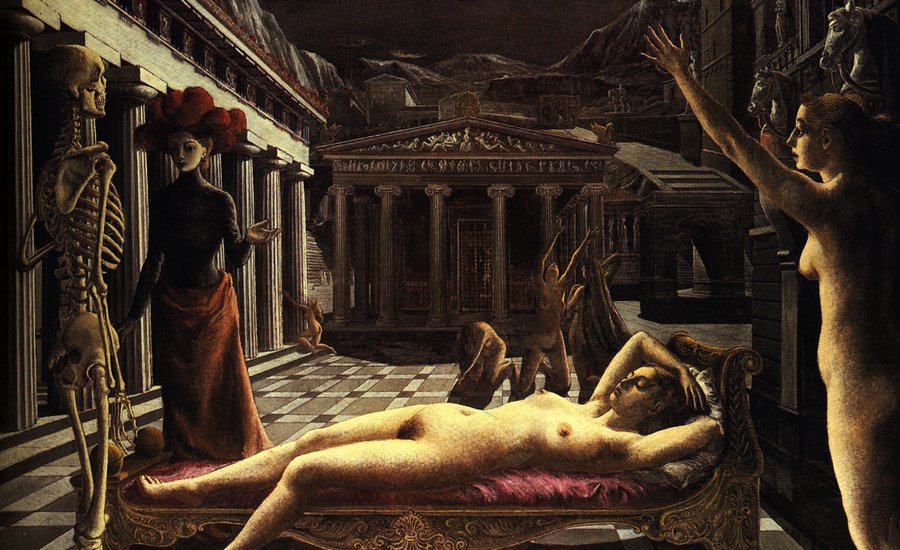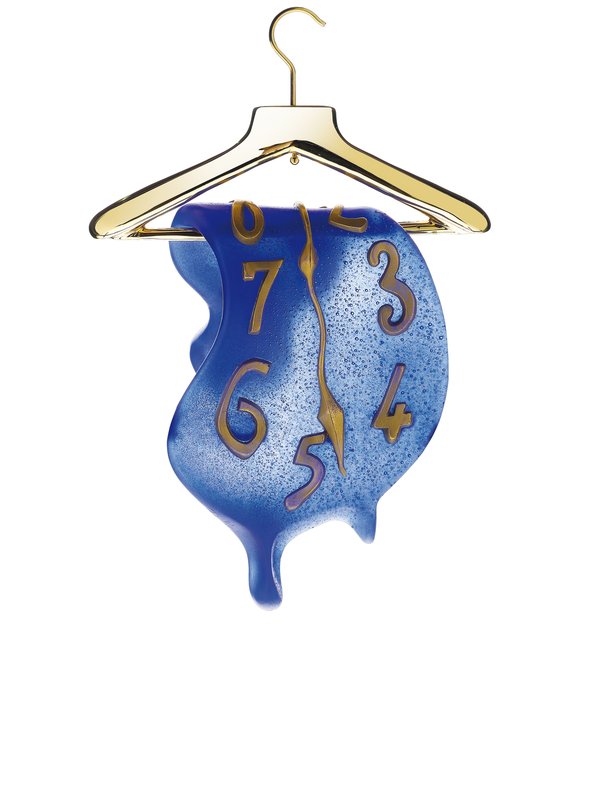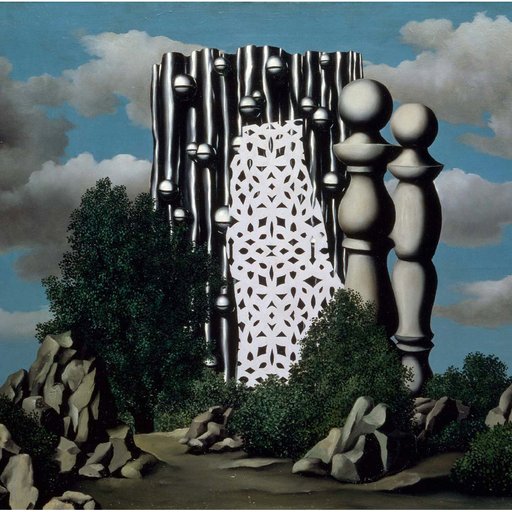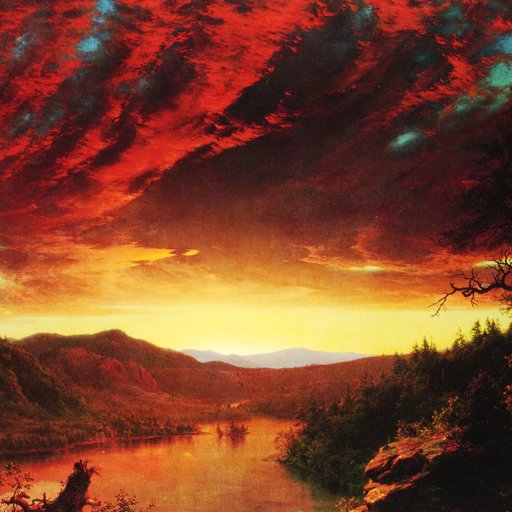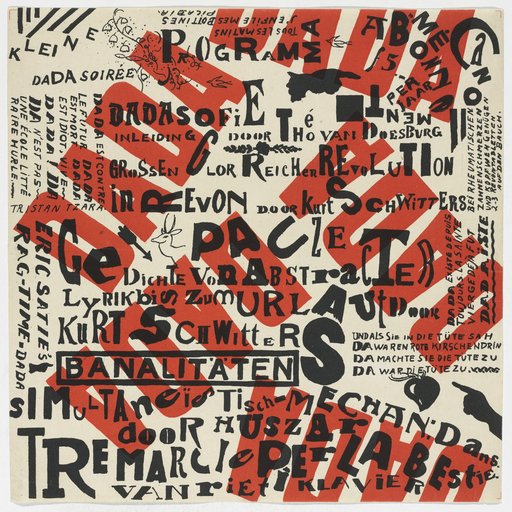Among radical 20 th century art movements (of which there are more than a few ), Surrealism is one of the few that’s been able to establish a hold on the popular as well as avant-garde imaginary, in no small part due to the outlandish public persona of its self-proclaimed ringleader Salvador Dalí . What’s sometimes forgotten, however, are the vastly different ways the Surrealist techniques of mining the subconscious were realized by artists from Armenia to the Americas. As theses 10 paintings excerpted from Phaidon’s The Art Book show, the results are diverse, hallucinatory, and wholly unique.
For more on the history of Surrealism, click here . To browse Surrealist-inspired works on Artspace, click here .
MAX ERNST
Forest and Dove
, 1927

The all-enveloping and stifling nature of this forest, in which the only sign of life is a solitary bird trapped in a cage, evokes a feeling of simultaneous enchantment and fear. The tangled trees seem petrified and loom over the bird in wild and irrepressible growth. Like many artists of his time, Ernst worked in many media. He produced an enormous collection of collages and introduced a technique called frottage. Similar to brass-rubbing, this involved laying a sheet of paper on a rough surface and drawing on the paper so as to reveal the relief of the object beneath. Because the artist had no control over the picture he was creating, frottage was also seen as a method of gaining access to the subconscious. The “chance” element of this technique, together with the hallucinatory quality of the image it has created, make the picture a fine example of Surrealist preoccupations.
EDWARD WADSWORTH
The Beached Margin, 1937
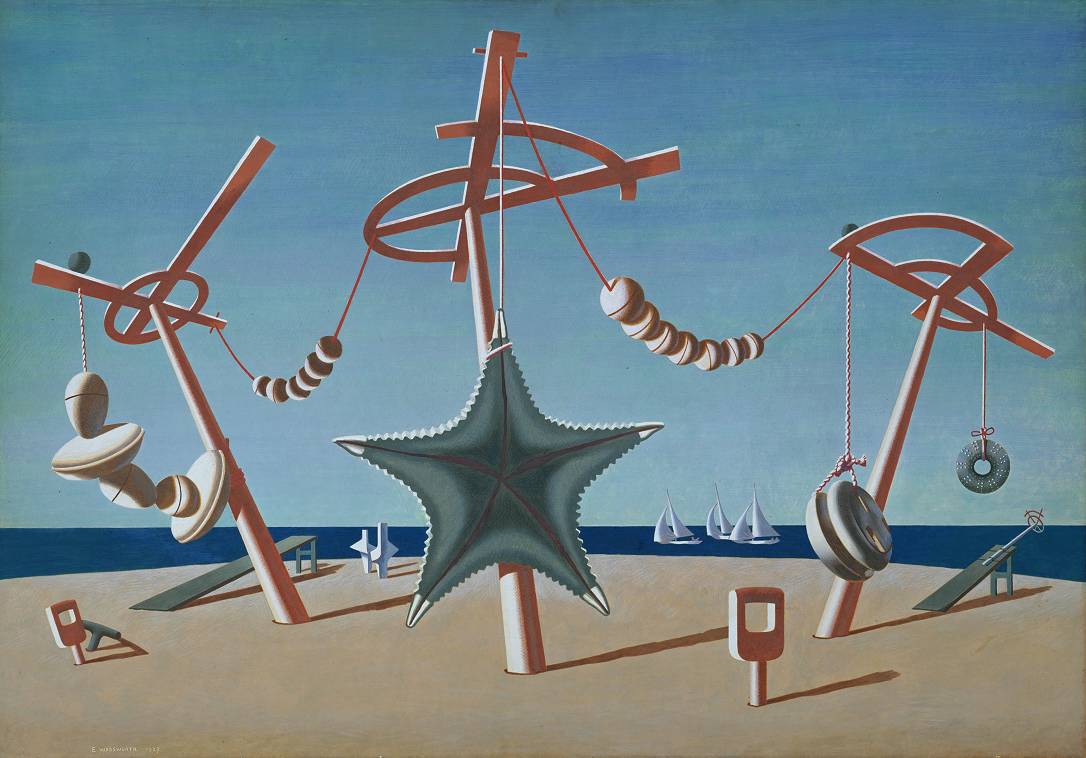
Nautical objects are assembled in bold relief against a marine background of sea and sand. The painting displays Wadsworth’s technical ability and meticulous draftsmanship: the minutest details are depicted with startling detail and the difficult medium of egg tempera (which he mixed himself) is handled skillfully. The imaginative quality of these fantastic geometric creations gives an intellectual pleasure much greater than is offered by the usual still life.
The painting comes close to Surrealism in its use of unexpected juxtapositions and in its hyper-real clarity. During the First World War, Wadsworth joined the Royal Navy and designed and painted camouflage for ships. This led to an overriding passion for the sea and ships, recurrent subjects in his work. As well as his paintings and engravings, Wadsworth also executed a number of mural decorations, notably for the liner Queen Mary.
HANS BELLMER
The Spinning Top
, c. 1937–56

A whirling skeletal female form spins on a top that she is holding in her bony hand. This peculiar image symbolizes woman turning the hearts and heads of men, as she spins in defiance of gravity. Relating to an unrealized project for a sculpture, conceived in 1936–9, it is certainly one of Bellmer’s most haunting images. The painting was reworked over several years, and only signed when Bellmer had found a buyer in 1956.
Polish-born, Bellmer became an active Surrealist when he moved to Paris in 1938. This painting reflects many of the movement’s preoccupations—its distorted, phantasmagoric imagery appears to have emerged directly from the artist’s subconscious fantasies. Bellmer’s central theme was that of the female body, often treated in an obsessively erotic manner. He is known particularly for his disturbingly fetishistic “Dolls,” a series of articulated female mannequins, and for his drawings and lithographs, executed with superb technical precision.
FRIDA KAHLO
What the Water Gave Me
, 1938
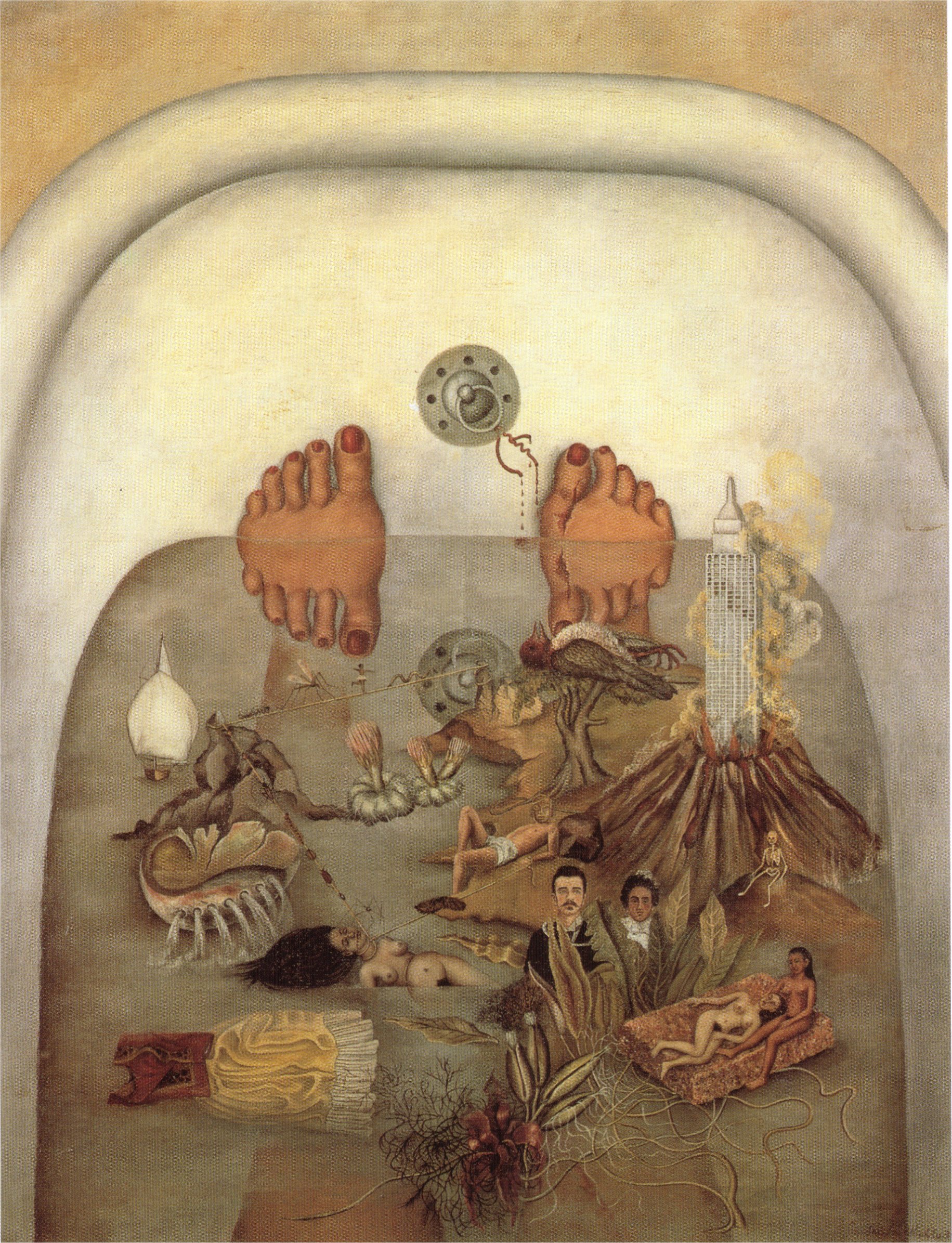
The artist’s hallucinations and imaginings run riot in this painting. It shows a bath time reverie, in which images of death, pain, and sexuality float on the water’s surface. As in many of her pictures, it is a kind of self-portrait, with Kahlo’s own legs painted from the bather’s viewpoint, showing her deformed foot with its cracked big toe. Her injuries, as the result of a serious road accident at the age of 15, destroyed her hopes of becoming a doctor.
This painting, considered to be her most Surrealist, is also the most complex of all her works, with its multitude of minute and irrationally arranged detail. She was married to the painter Diego Rivera; they had a turbulent relationship, and at one time she became a lover of Leon Trotsky. Kahlo has become something of a cult figure partly because from the mid-1940s she suffered from spinal problems and, bedridden, continued to paint, often in terrible pain, until her death.
VICTOR BRAUNER
Fascination
, 1939
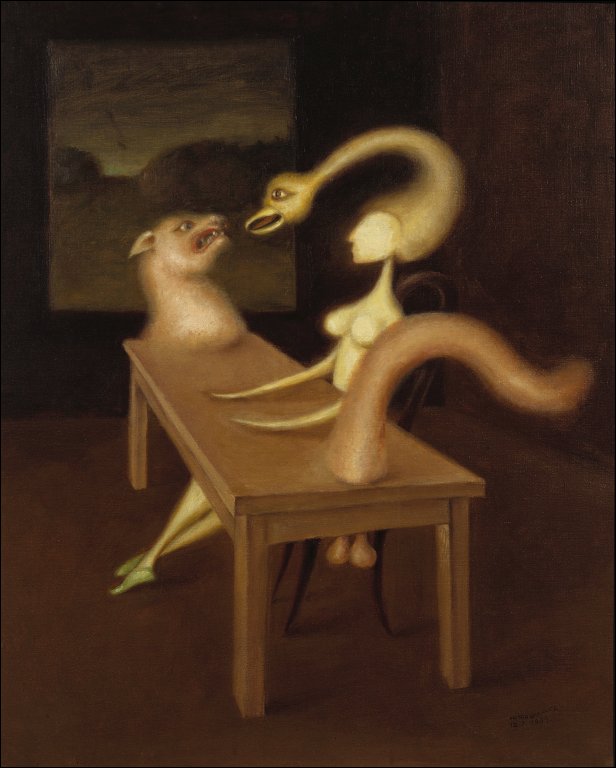
Muted browns and ochre tones decorate a spartan room with a table—part furniture, part wolf—at which a featureless naked lady sits nonchalantly as if calmly waiting for a meal to be served. Her hair curves up and forms a bird with a swan-like neck which viciously confronts the wolf ’s head growing out of the table. His tail and genitals are at the other end. Brauner produced a series of paintings such as this inhabited by strange hybrids of women, animals, and objects.
These absurd, hallucinatory fantasies spring from the enigmatic world of Surrealist art, in which the visual imagination is freed from the constraints of reason and logic. The Surrealists’ vision aimed to harness the unconscious to produce revelatory, stimulating images. Born in Romania, Brauner worked mainly in France. In 1931 he painted his Self-portrait with Extracted Eye ; the work proved to be prophetic, as the artist lost his left eye in a bar brawl in 1938.
ARSHILE GORKY
The Waterfall
, 1943

This apparently abstract painting is based on a small waterfall in a wood. It evokes a strong impression of a stream pouring through a rock, surrounded by overhanging trees and greenery. Vibrant colors evoke the serenity of bright sunlight and the sound of falling water. The beauty of the work lies in the artist’s ability to express an almost spiritual peace through the images of forest and water. The painting shows the magical, dream-like elements typical of the Surrealist movement, towards which Gorky was moving at the time, and the spontaneity of Abstract Expressionism.
Born in Armenia, Gorky emigrated to the USA in 1920. One critic has referred to him as an artist-in-exile, for whom art became a homeland. Gorky would often use images from his native land in his paintings. After years of poverty, he achieved brief recognition but hanged himself after suffering severe psychological trauma.
PAUL DELVAUX
Venus Asleep
, 1944

In a moonlit town Venus lies asleep, watched over by a skeleton and a dressmaker’s dummy. She lies with her legs open, dreaming of the seduction of Death. Perhaps it is the combination of youthful female beauty and death, of desire and horror, that makes this painting so disturbing. It was the hallmark of Surrealists like Delvaux to depict such strange, often beautiful, images that were inspired by dreams and the subconscious.
Delvaux came late to Surrealism, after experimenting with Impressionism and then Expressionism. He was popular in fashionable art circles after the Second World War, when Surrealism was in its heyday. Delvaux visited Italy in 1939 and was deeply impressed by Roman architecture. He is known for his dream-like images of beautiful, often naked, young women, usually positioned in front of meticulously rendered buildings.
JOAN MIRÓ
Women and Bird in the Moonlight
, 1949

Playing and mingling acrobatically with one another, these imaginary, frolicking figures project themselves vivaciously into the foreground. The background paint has been rubbed away to show the canvas underneath, lending it a raw, earthy quality. Evoking imagery from a primitive world, the magical figures conjure up thoughts of prehistoric cave-paintings, restored to us with all their freshness.
The painting forms part of a series entitled “Women and Birds” and is considered to be one of the most important of all this Spanish artist’s works. In its portrayal of weird, hallucinatory beings, which seem to spring from a subconscious dream-world, the picture is typical of the Surrealist movement, of which Miró became a prominent member. He worked with Max Ernst on the creation of the decor for Diaghilev’s ballet Romeo and Juliet, and also executed a wide range of lithographs, etchings and ceramics throughout his life.
ROBERTO MATTA
Untitled
, 1950
Strange shapes inhabit this fantastical, amorphous landscape. Visions from a dark imagination dart spontaneously across the picture surface and beyond, like electrical currents. They seem to resist any polar attraction to direct them into a semblance of compositional unity or rhythm. An unnatural blue-ish color suffuses the scene with an aura of mystery and otherworldliness, while the pictorial forms seem to be the result of a bizarre symbiosis of organic limbs and mechanical components extending into infinite space.
Matta first trained as an architect, but turned to painting in 1937. He spent the war years in New York and came into contact with many members of the Surrealist movement. His style of painting, using the “automatic” technique of entirely free brushstrokes without rational control, is typical of Surrealism, and was to inspire Jackson Pollock and Arshile Gorky among others.
YVES TANGUY
The Invisibles
, 1951

Abstract, biomorphic shapes climb rapier-shaped objects and appear to float upwards against a menacing, clouded sky. Tanguy was much influenced by de Chirico and joined the Surrealist movement after meeting the Surrealist writer and guru André Breton in 1925. The title and theme of this painting refer to Breton’s idea of the existence of invisible animals who have escaped man’s sensory frame of reference by means of camouflage.
The painting’s visionary quality is a clear illustration of Surrealist imagery: Tanguy has allowed his subconscious to “create” these beings, whose existence is uncertain yet impossible to disprove. This is a common theme in much of his Surrealist art, where amorphous creatures tend to inhabit barren, hallucinatory landscapes of the mind. Neatness and precision were deeply ingrained in his personality, and these qualities are also evident in his paintings.











